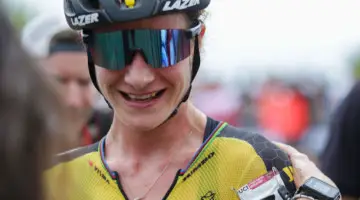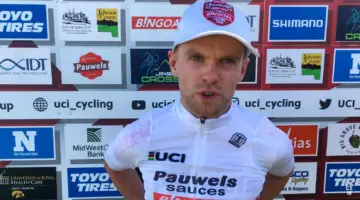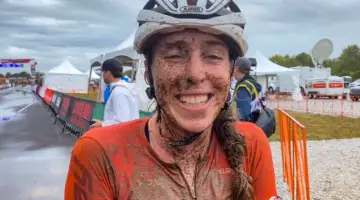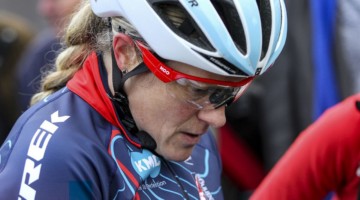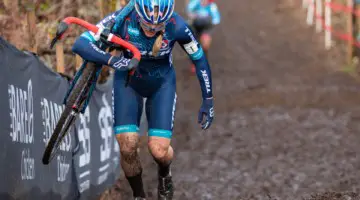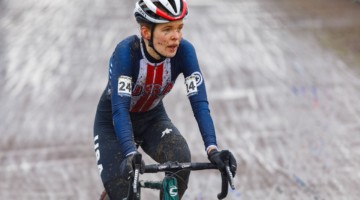Katie Compton (KFC Racing p/b Trek/Knight Composites) is a woman who needs no introduction around these parts. This season she won her 14th-straight national championship and competed for U.S. and European wins week in and week out and capped it with a second-place finish at the 2018 World Championships in Valkenburg-Limburg. Compton gave Sanne Cant (IKO-Beobank) everything the defending champion could handle before coming away with the fourth silver of her career.
Always an accessible athlete, Compton has been a regular on the pages of Cyclocross Magazine for her entire career. Earlier this season, I chatted with her about her European racing experience while she was home racing the Pan-American Championships and her weekend of racing at World Cup Zeven and Flandriencross.
To celebrate her incredible season and mix things up a bit, we decided to do a Q and Fn A and allow readers to submit your questions for the living legend. We got over 50 questions covering a number of topics ranging from Worlds to training to the family dog to … disc rotors.
I spoke with Compton via Skype and tried to ask as many reader questions as I could cram in. Our wide-ranging conversation is transcribed below. Compton said she enjoyed the experience and would be up for it again, so look for this segment to make a return engagement as next season draws near.
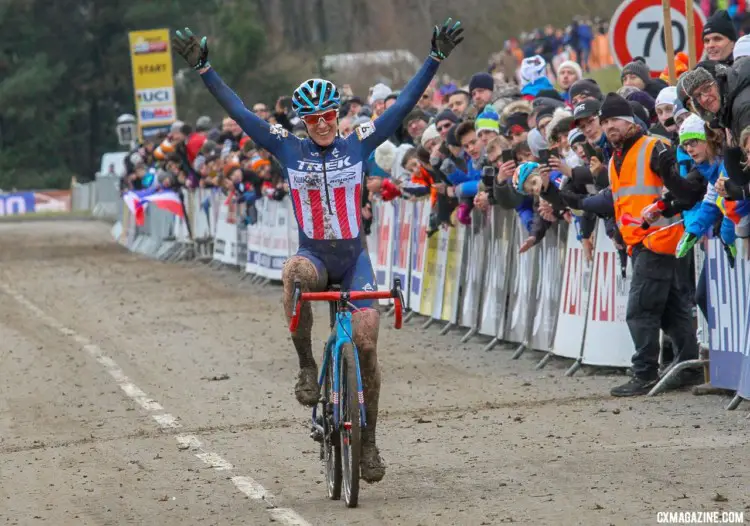
Katie Compton post-ups were a common sight this season. 2018 Nommay UCI Cyclocross World Cup – Elite Women. © B. Hazen / Cyclocross Magazine
Q and Fn A With Katie Compton, 14-Time National Champion and 2018 Worlds Silver Medalist
Cyclocross Magazine: Katie Compton, a 14-time national champion and Worlds silver medalist. We are taking some questions from readers. Are you ready for this?
Katie Compton: I am ready for this. I’m curious to see what they’ve come up with.
CXM: I think they have a good amount of questions, and I think when we talked last year, you mentioned perhaps going into coaching later and there were definitely a lot of training questions, so I hope you’re ready.
KFC: OK, I got to put my coaching hat in a bit. For sure.
CXM: First and foremost on people’s mind, and you knew this would happen, disc rotors.
KFC: Disc rotors. I love the fact that this is back in the news because of me.
CXM: One of our readers though did have a very funny way of putting this. This is from Facebook: Is it true that the brake rotor cut the f out of your name and now you’re just Katie n Compton?
KFC: I don’t think it cut any letters out of my name, but it did definitely take about a two-centimeter gash out of my knee. But honestly it was such a clean cut and I didn’t even feel it. Like I had no idea it was even cut until like, I noticed it bleeding. But then post-race when I was cleaning up, my Belgian mom’s soigneur, was like, I feel like you should get stitches. That’s a lot of blood.
I was like, no, it’s fine. I don’t need to worry about it. And then I sat down to clean up, but I looked at the gash and I’m like, no, I think you’re right. I think a few stitches would probably be prudent in this situation. So I got stitches.
CXM: Another question we got is how did you keep your composure? But I guess you didn’t notice?
KFC: I was honestly just so angry because I got crashed out in that first turn and it was just dumb because it’s the way the women were racing, like we’re all going to sort ourselves out. It’s always a cluster at the start, especially post-Worlds. The starts always seem like they’re more of a cluster than they have been all season. And the way this turn was set up, it’s kind of a tight right hand turn into the sand and there’s only one line in it.
I was in the line in like I think fourth place and then Helen came in on my right and just totally crashed into me and knocked me over. And then Nikki came on my left and knocked me on the other side. So it was just a stupid crash and I slammed my knee on the deck, but I also broke my shoe, the fishing wire got cut.
That actually affected me way more than the disc. My knee was fine, but I just couldn’t keep my shoe on. I lost a ton of spots because I couldn’t run very well, and I couldn’t pull up on the pedals, so it was like trying to lose as few spots as possible and trying to get a little bit of a gap because I knew I was going to have to do a shoe change.
I yelled at Mark to find my other shoes because my Belgian mom had my shoes in my backpack for post-race and just an extra pair of shoes just in case. So that took about a lap. I spent a lap and a half trying to keep my shoe on and pedal, which kind of made it tricky in the sand as well as trying to run over the stairs.
But yeah, I had to come in for the change and that was good. Then I just took a lot of time to get back towards the front. And by that point I think I finished a minute and a half down, but considering how much time I lost in the first two or three laps and having to chase, it wasn’t too bad.
CXM: You have the overall series more or less locked up though. Right? So did that give you a little bit of consolation?
KFC: Yeah, it did. I just think as a bike racer in general, when I line up at the start I want to do the best I can to get on the podium as much as possible. I just get to that point where I just put my head down and go. Even though I had the series locked up, I don’t like to quit if there’s not a good reason for it. So I tried to make the most of it and catch as many people as I could and still have a good finish considering a poor start.
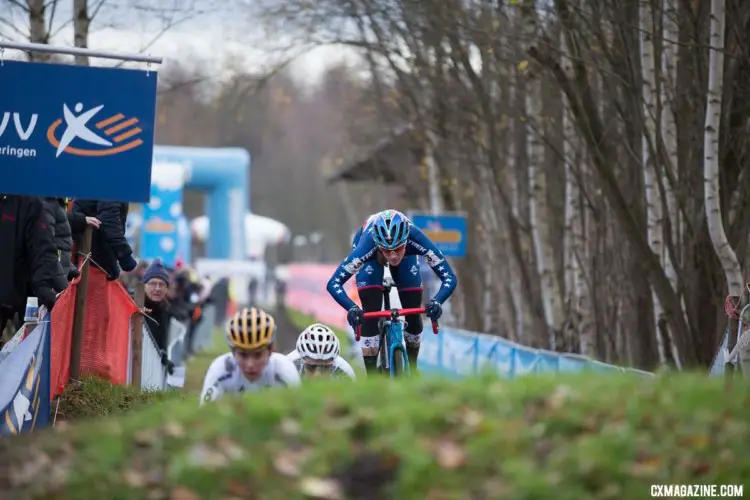
Compton won the IJsboerke Ladies Trofee overall series this season. 2017 Cyclocross DVV Verzekeringen Trofee #4 – Essen. © Cyclephotos / Cyclocross Magazine
CXM: And your knee is okay? Is a healing okay?
KFC: It just sore from the trauma of getting hit. It’s a little tight, a little sore, but it’s healing well, and I think it’ll be fine.
One thing I’d like to say about this. I’ve had quite a few comments about it’s unsafe or we shouldn’t ride disc rotors, and I’m just like, very few people actually get hurt with disc rotors. People get hurt riding their bike all the time, whether they run to a tree, they get hit by a car and even the race caravan takes out riders.
I don’t think it’s that big of a safety issue. It’s more of a concern of individual riders making poor decisions and making mistakes, which happened in the past, whether you’re riding disc brakes or cantilever brakes. I think they’re safer and I’m still going to ride them and not worry about getting hurt because it’s just by grace it happens that way sometimes.
CXM: We had some questions about the World Championships. I heard you had a pretty good ride there from what people tell me. A couple of weeks later, how are you feeling about that day and your race?
KFC: I feel good. I think it was a really good race for me. I felt pretty good. I rode strong and ran fairly well.
Honestly, I couldn’t have gone any harder or even at the end there. You tell yourself it’s a World Championship, push harder, push harder, and I couldn’t push any harder. I crossed that finish line and was like, oh my God, my body hurts more than it ever has. I know Sanne felt the same way because neither of us would give an inch and we were just trying to get to the finish first.
I think the biggest issue with that race for me was we didn’t pick the right pit box. I lost a lot of time with that pit box, which was my fault. I thought it was good pit box, and it is when it’s a dry race, but it was a wet race. That was a tough lesson learned there.
And then the downhill, I didn’t get the downhill dialed as much as I should have. Sanne was definitely better on that than I was. Those were the two points where I was a little bit disappointed in not doing it better, I’ll say. But other than that, I had a good race. I’m happy with the results.
CXM: That’s funny, because before we jumped into the reader questions I was going to ask about the pit box choice and descent. I imagine the descent had to be really frustrating since, that’s your thing.
KFC: It is my thing. That’s why I was so frustrated. I kept falling into the stupid super deep rut for some reason. I kept trying to stay out of that rut, but I kept getting stuck in it and it was pissing me off. I was like, what the hell? How do I keep messing this up? And so I just started running it towards the end and even that wasn’t very quick.
That was just on me. I just didn’t have a good day. Sanne was doing it better. That was just frustrating on my part, but that’s what happens with bike riding sometimes. Sometimes you’re on and sometimes you’re just a little bit off and that section I just didn’t have it dialed in.
CXM: So then this was an interesting question that someone asked when we talked to Sven. You’ve battled against Sanne Cant all season, so who’s the toughest competitor you’ve raced against and why?
KFC: Overall in my career or just the season?
CXM: Let’s say in your career, taking a big picture view.
KFC: I would say Marianne [Vos] and Sanne [Cant], for sure. Sanne, she’s good at pretty much all the courses and she’s really strong at the end of races and she’s good technically. I think she’s probably the best all-around racer I’ve raced against.
Marianne is always really strong, and she’s really good on the really fast, speedy courses, but she isn’t as strong in the mud. When she’s on, she’s on, I mean she won worlds in Koksijde, so she’s obviously a good sand rider. I just think she’s better at the fast kind of courses.
I would say those two would be the ones that I’ve had the hardest time competing against. I’ve only beat Marianne a few times, and I’ve only beaten Sanne a few times too. Well, right now. When she was younger I was able to beat her a bit more. But now she’s coming into her prime and she’s riding really well, so it’s a little different now than it was a few years ago.
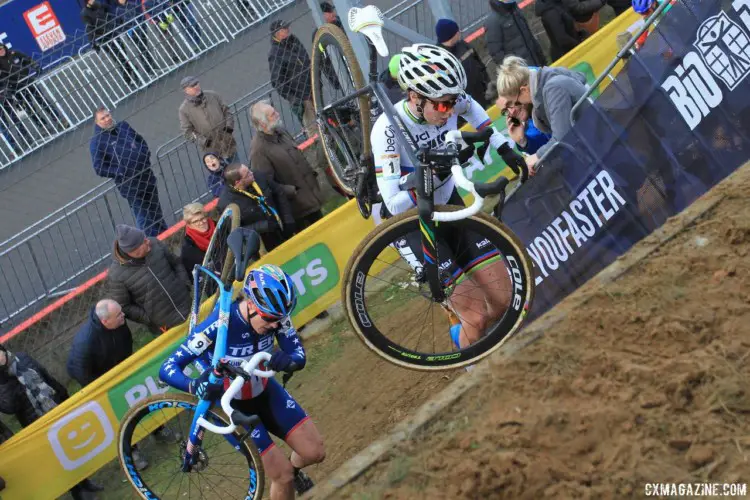
Katie Compton and Sanne Cant treated fans to great battle after great battle this season. 2017 World Cup Zolder. © B. Hazen / Cyclocross Magazine
CXM: We have a question from Barry of Ireland and Bruce of Maryland. People want to know the story behind the kit at Worlds.
KFC: Okay, so that was just a mistake. That was a simple mistake where a person at USA Cycling just pulled out the clothing and something was not put away in the right spot. And so with the way the bags go, it doesn’t tell you what kit is in it, it just says USA National Ladies Skin Suit. Unless you take it out of the packaging, you can’t tell what skin suit it is.
I think they pretty much grabbed the wrong thing, and I got my bag of clothing and I didn’t even notice it was a different skin suit until after the race when we are notified it was the wrong skin suit. So it was just a mistake. I think it was a national champion skin suit that was for other kinds of racing, but it wasn’t an actual national team kit.
And since I just put the skin suit on the day of the race and you’re covered in layers until you go to the start line and take your jacket off, nobody noticed. I didn’t notice. During the race it was different compared to everybody else’s, but there was no reason for it besides a simple organizational mistake.
I think people read into it a little bit, but it was unintentional by everybody involved. So I have a different skin suit for no good reason besides the mistake. That’s funny. Happens. It happens.
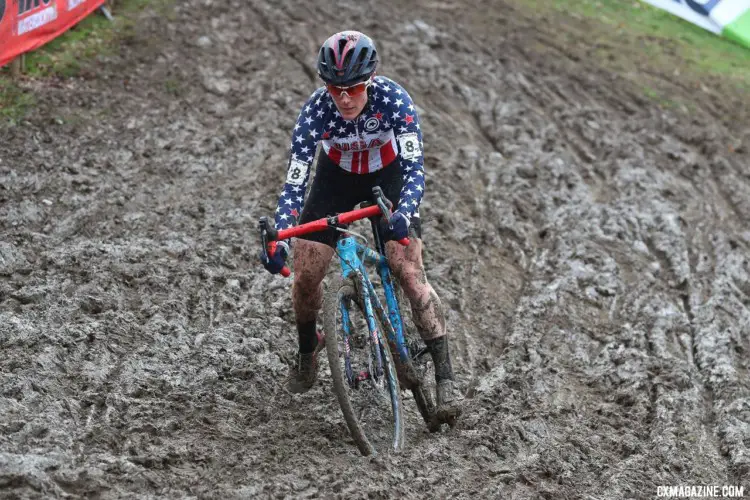
Katie Compton’s kit was a little different than the other U.S. riders’ at Worlds. Elite Women. 2018 UCI Cyclocross World Championships, Valkenburg-Limburg, The Netherlands. © Bart Hazen / Cyclocross Magazine
CXM: The course at Worlds looked very technical and challenging. So a question from Lee of Colorado is what do you think makes a great cyclocross course?
KFC: I like courses with variety that challenge riders physically and technically. Courses that kind of take the tactics out of it, where you have to race against other riders as well as the course.
So for me, of course it has some ups and downs, some off-camber, mud, sand and even some climbing. I’m good with that. Anything that is physically hard and mentally demanding when you’re focusing on it.
Valkenburg was probably the hardest course … actually no, it is the hardest course I’ve ever raced with the climbing, the off-cambers, the focus it took to ride that mud. It was definitely a challenge from start to finish.
CXM: How much easier do you think that course would have been in different conditions? To what extent do you think the mud and stuff like that can make a course that much harder?
KFC: The mud makes it harder because you need to have technical ability to ride it well. It takes out some of the pure physical strength, like if somebody is just as strong rider a straight line, they’re not going to have a good performance on a course that’s muddy and technical.
So I think having it where it’s both physically demanding where we had to be fit, we had to be strong, you had to be a good runner, and it also required technical skills where we had to have the mental strength to focus on that course the whole time. I think that’s what makes it hard and what makes it a true cyclocross race.
CXM: We had a few readers point out that obviously you and Mark are very attentive to tech stuff. Did you guys make any big changes or adjustments for the course at Worlds?
KFC: No, I think I just dialed in to a tire pressure and committed to riding mud tires. Everything else was the same. My bike setup was the same. I think mostly it was just tire pressure, just dialing that in for the conditions. That would be the major change.
CXM: I’ve got some more tech questions later, but the big thing that seems like people want to know about is training. So now it’s time to put on your coaching hat.
This one is very appropriate for the Valkenburg course. David from Facebook wants to know what your running training looks like and if you have any tips for the Cat 4s out there?
KFC: So this year I didn’t do any running, which was unfortunate because I wish I had. I have run quite a bit in years past, and I’ve never needed the running. And so I was like, well maybe I’m wasting my time with the running training since, you know, we haven’t had any running courses.
This year we had tons of running, and running kind of separated the group quite a few times. I feel like running was something I should have done more of.
I think it depends on where you’re racing and who you are. If you know you need quite a bit of running and you’re racing, I think you should do some running. If you live in a place where it’s dry and you never have to run, I wouldn’t worry about it too much.
I’d worry about dismounts and mounts. I’d worry about stair sprints. If you do run, run fast. You’re sprinting, you’re not running at a jogging pace. Thinking about your training, maybe you want to run twice a week for maybe 20 minutes at a time, or enough to warm up, run some stairs and sprints and then cool down. I’d just think about being specific with your run training depending on what kind of racing you’re doing.
CXM: That’s very interesting and somewhat, I don’t know if ironic is the right word, but you know, the season before your big Euro season you decide to not do as much of the running training. That’s a good segue to another question from Trixy. She said she last saw you in 2013 in Rome and is hoping she’ll be able to see you in Europe again next year. Do you think you’ll be doing another big Euro schedule next year?
KFC: Yep. I’ll be in Europe again next year. I’ll be doing the DVV series. I’m racing the World Cup, so yeah, I will be in Europe and she can come see me race again.
CXM: Does that mean that your running training is going to change this offseason?
KFC: I’m already thinking about it. I’m probably going to start running more. I miss running. I enjoyed it when I was doing it. I was just I felt like it hurt my ride training. So now I have to kind of figure out a better way to balance that. I was doing quite a bit of running when I was running, so I feel like maybe it was just too much, and I need to find a balance to perform better.
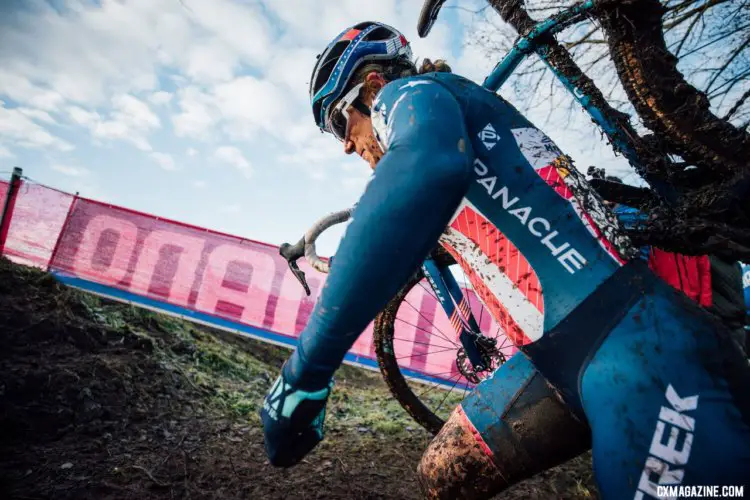
Katie Compton will likely be doings more running this offseason to get ready for another European campaign in 2018/19. Elite Women, 2017 Zeven UCI Cyclocross World Cup. © J. Curtes / Cyclocross Magazine
CXM: Beth wants to know about strength training. Do you do it and if you do, are there any exercises that you would recommend for amateur athletes to do?
KFC: I do not do any strength training except on the bike, a lot of over-gear work on the bike. I do like yoga and push ups, pull ups, that sort of thing. With my body type, I put on muscle mass quickly and easily and every time I lift weights I just bulk up and it makes me a slower bike rider. I like being strong, but it doesn’t make me pedal my bike faster. So for me, I don’t do strength work.
There are athletes who will benefit from it, and I think especially as both men and women age, strength training is a really important thing to do. Maybe two, three times a week depending on your schedule and ride training.
I think if you’re going to do it, multi-joint exercises, those that stress the major muscle groups and balance exercises are the best ones to do for training and to be efficient with your time at the gym.
CXM: Similar to on-the-bike training, Chris from Pennsylvania wants to know, power meter, yes or no?
KFC: Yes, I have an SRM power meter on all my ’cross bikes and my road bike. Luckily, SRM has provided me with power meters for quite a long time, and I do train with them. I find them to be the most accurate, easily ridden power meters, I’ll say, just because you can change them between bikes as needed. And I feel like they’re the most accurate too.
I train with an SRM most of the year, but once the season starts, I use it a little bit less because I look at race results and how I’m feeling and then kind of base my training on that. But I would say nine months out of the year, I’m on an SRM.
CXM: And so for amateur athletes, would you recommend a power meter, or is there a level where you would say this is definitely an investment you should make?
KFC: I feel like if you’re working with a coach, it helps to have a power meter, so the coach can actually see what you’re doing and see when you’re getting tired.
I feel like as an amateur, if you just want to go race your bike and have fun, you don’t necessarily need a power meter. If you’ve kind of hit a plateau and you don’t use a power meter, maybe now’s the time to get one. It kind of depends on where you are and what your goals are. If you want to improve as a bike racer, it helps to have one.
Also, after using one long enough, you know your body, you know what the power feels like when you’re doing certain intervals and you can dial in your perceived exertion really well. Then you will know when you should use it and when you can just leave it at home and not stress about numbers.
I feel like there’s a balance where they’re good to use, but you also have to know when to just go ride your bike and have fun and not worry about numbers. The more experience you have, the more you know when those times are.
CXM: For ’cross, are there ever instances where you tried to take that data and look at it and use it?
KFC: I did when I first started using a power meter on the ’cross bike. I think I raced on it for a couple of seasons and trained on it pretty consistently, so I could get that data. Now that I know what the demands across a race are, I can kind of dial in the training and the intervals to match what the power data says. So yeah, I do. With any athlete I’m coaching, I look at what the demands of their discipline is, what kind of power numbers they have to put out and then design the intervals to specifically work on what’s going to make them race better in their discipline.
CXM: We have a question from Olegario of Pennsylvania, and I think this is actually super pertinent to cyclocross given the mental aspect of it. Do you incorporate any sports psychology into your training?
KFC: Maybe not, per se, a specific sports psychologist, but I do think about it. I do visualize things. I do try to calm my nerves with like deep breathing, kind of like a meditative process and focus prior to the race. But honestly, I’ve had a pretty good head for racing my whole life, so I’ve never felt the need to use a sports psychologist.
That doesn’t mean that they’re not super helpful in that they could really help certain athletes perform. But for me, I’ve just kind of always just raced my bike and not stress the details. If my legs are good and I’m fit, you know, I’m going to get a good result.
CXM: And then shifting gears a little bit, Corey from Minnesota said she heard a rumor you do most of your training off-road. Is that true?
KFC: I don’t think that’s true. I do quite a bit on the road. I do quite a bit on gentle bike trails in Colorado Springs. I ride a mountain bike in the offseason, but I kind of like to change it up depending on what I’m training for and what time of year it is.
I ride the road bike, ’cross bike, track bike, mountain bike. It kind of just depends on what the training calls for and what the weather’s doing and kind of what I feel like riding. Honestly, I haven’t actually kept track exactly how much is off-road and how much is on the road. I just kind of go by what I need to work on. So yeah, a little bit of everything.
CXM: BMX bike though? You mentioned a lot of bikes!
KFC: No, no BMX, no BMX bike. I feel like I’ve got enough options and bikes and there’s only so much time in the day to ride and train. I’m pretty good with the four disciplines. I’m pretty good with that.
Good morning here is @KatieFnCompton being chased by a cop riding a tricycle dragging a keg with fireworks strapped to it. Happy Monday. pic.twitter.com/xhoKmRWKZy
— Brad Sohner (@bradsohner) June 19, 2017
CXM: Did you and Mark have a tandem?
KFC: No. No. I enjoyed when I raced tandems, but honestly, we would both want to be the pilot and it wouldn’t work, so it’s just not going to happen in our household.
CXM: That’s the key to a good relationship, knowing your partner, right?
KFC: Oh yeah. We’d much rather ride on our own and have her own bikes and ride together that way. We’re actually pretty good riding together. We can ride two abreast, we can ride single file and not talk to each other for a four-hour ride and that’s fine.
I’d much rather just do it that way than to have to share a tandem. I mean we share enough as is, and we spend a lot of time together, so there have to be limits to have a healthy marriage. I feel like a tandem doesn’t need to be brought into the equation.
CXM: Then one last training question from Todd of North Carolina. He wanted to know if you’re going to go for a ride with no training in mind, so maybe right now postseason or whatever, what would be your top choice? What would you go do?
KFC: I’d probably go for a mountain bike ride because I’m kind of over the ’cross bike. I’d just want to do something fun. I would probably do long mountain bike ride in the mountains, single track riding with friends, conversational pace, fun downhills, ride my enduro bike. That would probably be a fun thing to do.
CXM: Cool. We’ll move into some tech questions, which I know something that, again, you and Mark are very attentive to, so it’s always very interesting to hear your perspective on these things.
We’ll start with clothes, of course. Don of Oregon wants to know what the story behind the pre-race shorts are, the mountain bike shorts and if you wear them overseas as well?
KFC: They’re just baggies. The reason I wear them is because when the courses are that wet and damp and it’s easy to pre-ride without getting too sweaty. And then when I’m done riding, I can just peel them off and the mud’s gone and I still have a clean chamois.
It’s an efficiency thing where I can do my pre-race warm-up, check out the course and have a clean chamois at the finish and not have to worry about another layer and another change of clothes. At Belgian ’cross races, you need three different kits to get through one day of bike racing. That’s a ton of laundry and a lot of muddy clothes. I try to minimize muddy clothes by wearing rain gear or baggies to peel off after the muddy pre-ride.
CXM: How long have you been doing that? I remember seeing you use them in Hartford, so I imagine you’ve been using them for years now, huh?
KFC: Quite a few years. I used them in Hartford because it was cold out and it’s just a little bit extra layer to stay warm. And they’re pretty comfortable to ride in. So it just depends. If it’s muddy or cold out, just put on a pair of baggies and it makes everything more comfortable for riding. Then in perfect conditions I won’t worry about it, or if it’s cold and dry I’ll just wear a pair of tights. Just depends on the weather.
CXM: It seems like they’ve become almost iconic. Any thoughts on some KFC-brand pre-ride shorts?
KFC: Well I just find it funny because of the amount of mountain bikers that wear baggies, and I’ve noticed even some of the mountain bikers warming up for ’cross races wearing them. Even Eva Lechner and Katarina [Nash]. I think since I come from more of a mountain bike background, you’ve got them in your closet anyway, and they’re an easy way to keep the dirt off and stay a little bit warmer. I feel like there’s plenty of baggies out there. I might be wearing them for ’cross, but I’m definitely not the first person to wear them.
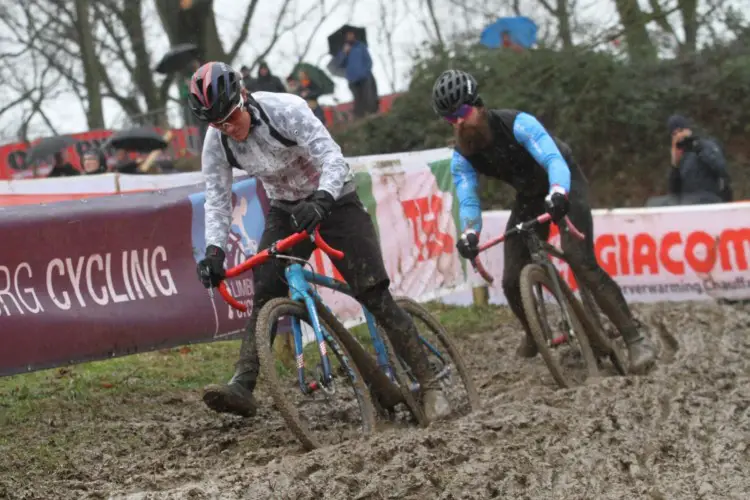
Katie Compton had her baggies on during her Worlds pre-ride. © B. Hazen / Cyclocross Magazine
CXM: Scott from Facebook noticed you switched tires this year. You were on Donnelly last year and this year it’s Challenge. What’s the story behind the switch?
KFC: I just wanted a different casing for racing in Belgium. The cotton casing of the Challenge tires, I liked the ride feel of it and it was an easy transition with the Challenge support in Europe, so it was an easy sponsor change for me. So yeah, mostly the cotton casing. The Donnelly tread is really good and the Challenge is really good. The ride feel is the important part for me.
CXM: What’s the mix of what you ended up running in terms of the Challenge treads between the Limus, the Baby Limus, the Grifos and some of the others in the Euro conditions?
KFC: My favorite is the Baby Limus, that’s probably my go-to tread for all conditions except when it’s really muddy. The Baby Limus is for like the in-between muddy and then the Chicane is a really good tire for fast courses that have some loose turns. Those three tires are probably my favorite, but the Baby Limus is probably my go-to tire.
CXM: Eric from California wanted to know about your bike. The Trek Boone, with the IsoSpeed decoupler, now that you’ve been riding on that for a whole year now, how has that affected your steering and handling?
KFC: It just kind of takes the edge off the bumpy stuff. Honestly, I don’t really notice that it’s there in the handling of the bike, which is good. You don’t want to notice it when you’re riding the bike. You just want it to perform the job it’s made for without noticing. The IsoSpeed decouplers in the front and back definitely takes the edge off. It makes it a nice smooth ride, so I’m pretty happy with that.
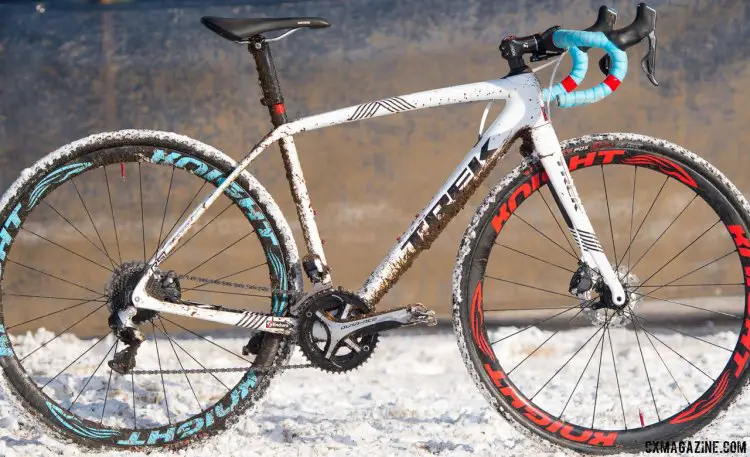
Katie Compton’s 13th National Championships-Winning 2017 Trek Boone cyclocross bike with a fresh title and coating of Hartford’s Riverside Park’s mud and snow. © Cyclocross Magazine
CXM: And so along those lines, what do you think, uh, let’s pick a period of let’s say 14 years, what has been the biggest or most important change you’ve seen in the technology of cyclocross bikes?
KFC: I think the electronic shifting has been my favorite. It’s funny because I think every little thing helps. I love the carbon frames, I love the electric shifting and then the disc brakes have come a long way too. So I think the way the bikes are set up right now, they’re pretty great and pretty lightweight for what they are.
It’s just those little changes, but I feel like, the electronic shifting, I’m amazed at how well it works in crappy conditions. So that would be the biggest technological change over my 14 years, I think.
CXM: I was having this conversation with someone and it’s like if you pull a mountain bike from, say 15 years ago, they’ve changed drastically. Pulling out your 26-inch hard tail with linear-pull brakes and it’s kind of scary to race on, whereas my girlfriend was racing on a 10-year old cyclocross bike and it was fine. Do you see any other frontiers or ways that ’cross bikes might change down the road?
KFC: That’s a tough call because there are limits to how much you can change them and have them still be a ’cross bike. I don’t think you need to add any more suspension, besides like what is done with the decoupler or what other companies have done to take the vibration or the roughness out of the bike from having to ride over rocky, rough terrain. I think wider tires make a difference, but we’re limited on that. Tread makes a difference. The bikes are pretty light. Most of them are carbon. Those are all things that make them ride better. But it’s not as drastic as mountain biking, where you go from a 26-inch hardtail to a 29-inch full suspension that just rides like a pillow.
I think for ’cross, we just don’t have the amount of changes we can make compared to like a mountain bike. So I don’t know, honestly. I don’t know how engineers do it, how they keep making it better. I’m not that creative with technology, so I like to ride them and I know it feels good, but it’s hard for me to kind of say what we’re going to happen next and technology department.
CXM: One area that is changing in ’cross is more riders are riding tubeless. Bob from New Mexico wants to know what your thoughts are on tubeless and for someone out West, if going tubeless and wider is an alternative to riding tubulars. Is that something you’ve thought about
KFC: Personally I will never do that because I like the feel of tubulars too much. I haven’t found a tubeless tire I like on the ’cross bike yet, especially not for racing. But if you’re training and you’re riding in a place like New Mexico or Colorado or out West where we have goatheads and tons of thorns and cacti, I think tubeless is a good option. You can change your tires easily. You’re not running them as low because you’re riding rocky terrain anyway, so running a low pressure isn’t as much of a worry.
I think if you can find a tire that you like that has a good tread and maybe a bit higher volume, I think racing and training on tubeless tires is a great option if that’s what you want to do, but for what I need, it doesn’t work. I need a nice soft cotton casing, so I can ride a low pressure and have a really good ride feel.
CXM: Have you done any experimenting in the offseason with running wider tires for training?
KFC: I ride wider tires on my road bike, usually 28s or 32s, which I really like. I think for the ’cross bike I don’t because I have to race on 33s, so training with wider tires isn’t going to help me for race day when I have to ride something narrow. For the mountain bike, I try to ride a higher volume, but for the ’cross bike, I just stick to the 33s and call it good.
CXM: Yuko from Massachusetts has a question about gloves, having recently moved from California to Massachusetts and gotten to race the 18-degree day at Noho.
KFC: Ouch.
CXM: Have you found any good cold weather gloves or do you have something to look for in cold-weather gloves that still gives you control on the bike?
KFC: I don’t think that’s even remotely possible to find something that keeps your hands warm and still gives you dexterity for holding the bars and shifting. It’s a compromise. I think battery-powered gloves are the way to go if your hands are really cold and you’re riding in cold environments. You can get away with a little bit lighter glove, but it still keeps you warm and lets you shift.
My hands run hot, so just a regular winter glove will work for me in cold conditions. I don’t really care about having to shift well when I’m training, and if I’m racing, I can manage to get through a race with cold hands for 45 minutes, so I don’t really worry about it.
But yeah, if you’re training and commuting in those conditions, I think battery-powered gloves are the way to go. Or the kind of gloves that are attached to the handlebars, where you just put your hands in them. I think those are your options for cold-weather riding.
CXM: So you’re saying Bar Mitts?
KFC: I think so, yeah. Like I don’t have a pair of them, but plenty of people who live in cold environments and have fat bikes seem to love them. So those people will probably know what keeps your hands warm and what doesn’t, I would guess.
CXM: So maybe we should to see if a special edition of cyclocross Bar Mitts has been invented yet.
KFC: Probably not. But you know, if there’s a market someone can do it.
CXM: I’m in Madison, Wisconsin, where it’s obviously quite cold and Bar Mitts are a go-to for many bike commuters around here. I’ll keep my eyes peeled to see if there’s any, you know, super dexterity version of them for cyclocross.
KFC: I don’t know, I just don’t think there is because you got to give something up. You want your hands to be warm, but you can’t shift. I think maybe the best option is grip shift. You have to wear thick gloves, maybe find some old grip shift and see if that works for being able to brake and shift while you can’t feel your hands.
CXM: So that is a perfect segue into our last segment here, which is kind of a free-for-all potpourri, like on Jeopardy. These are the questions that don’t necessarily have a category but are still good questions. Willy from California wanted to know about Single Speed Worlds down the road, speaking of not needing to shift.
KFC: You know, I have been thinking about that. The only thing keeping me from doing it is tattoos. I don’t have a tattoo, I’m not a particularly big fan of tattoos. Well just maybe on me. I don’t want one. So that’s my issue.
Like you can’t win unless you get a tattoo and I’m not the type to race a bike race and not win just so I don’t have to get a tattoo. So that’s my thing. Until I can commit to getting the tattoo if I win, I won’t do it. I’d like to do it, but that’s my issue. I don’t want the tattoo. So there you go.
CXM: We’ve seen from Sven Nys, aka Stan Nice, former pros, I think, need a singlespeed alter ego. Any thoughts on what your singlespeed alter ego would be?
KFC: I have no idea. I haven’t put that much thought into it. Like that’s where my lack of creativity comes into it. I haven’t thought about it and it might take me a little bit of time to figure out a costume and race it as a different personality. I don’t know if I can.
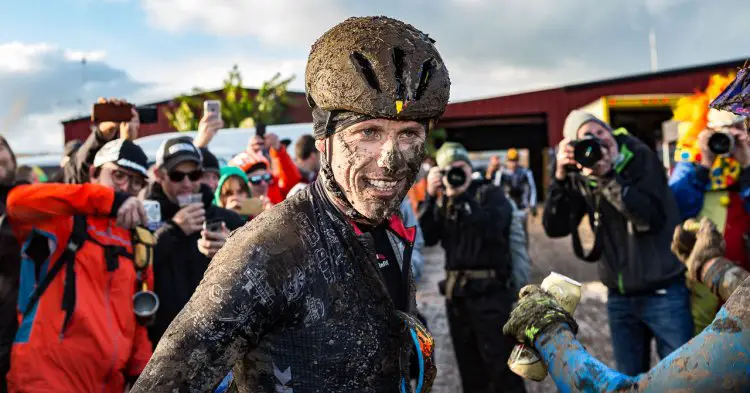
Will Katie Compton follow in the footsteps of Stan Nice and race Singlespeed Worlds? 2016 SSCXWC. © Ryan Richardson
CXM: Changing direction a little bit, this is a great question from Arnold of Singapore. Singapore has a developing ’cross scene and he wanted to know what your thoughts are about getting more women involved in both riding and racing bikes.
KFC: I think first, for getting more women on bikes, you need a social environment and it has to be a safe environment. It helps to have other ladies riding bikes around them so they have a good social circle.
You also have to have people teach women how to do it. People who are very patient and understanding and not pushy. And sometimes guys don’t know how to do it, how to teach well without making the girls angry. I’ll say it’s tough. I feel like you need to encourage them. They need to have a good environment.
You need to keep it fun, but I also feel like you also need to give them a bike that works well. That means nice equipment and light equipment and not just an old heavy beater bike that their boyfriend gave them because they don’t want to use it anymore. Just because we’re women doesn’t mean we don’t want to ride really nice, light stuff. Give them a tool that they’re going to have fun on. That works well, that’s lightweight, but they can be safe on.
And then just the environment with people who like to ride bikes and are supportive to kind of get them involved.
CXM: John and Melissa both asked basically the same question; what drives you to compete and achieve at the highest level year in and year out?
KFC: I like the challenge of it. I like the training part of it. I like pushing my body. I like being fit. I just like the excitement and the adrenaline of it and like the nerves and everything that’s involved with it.
I don’t know, it’s hard to put my finger on why, I just know I love it and with some things you just don’t understand why, but you just can’t stop doing it. And for me that’s kind of like bike racing.
Some days are definitely hard, some days I don’t feel like going training, but then feeling strong and riding well and having that adrenaline rush, it’s addictive and I like that the most.
CXM: Is there a moment that you can look back on and say this is when I fell in love with cyclocross, or this is what I wanted to do?
KFC: Probably my first year of college. I had a great group of friends to ride with every weekend and it was just super fun social thing to do. And the bike racing part was fun. Like I enjoyed the technical bit. I was a big rider, so I didn’t have to worry about climbing, I just worked on technical skills and power, which for me was perfect for my body. And I had success from an early start, so I feel like that altogether made ’cross the most fun for me.
Of course I’ve always liked mountain biking and road and track, but with ’cross, I think I love the speed, I love the technical bits. I love the tactical parts where you have to have some mental focus on it and think about the race. I think it just has a good variety of things. It keeps my mind busy, which is good. I like it.
CXM: And do you mention college, which I guess I should know this. Where did you go to college and what did you study?
KFC: I went to the University of Delaware and I started exercise science.
CXM: They’re like the Mud Hens?
KFC: The Fighting Blue Hens.
CXM: You guys have a great mascot.
KFC: Yes, we do. Go Delaware.
CXM: Speaking of people from Delaware, Jiggs asks how you and Mr. Katie Compton met.
KFC: We met in Quebec City at the Paralympic Blind World Championships. That was all the other sports, not just cycling world championships. We met there and we got along, stayed in touch and I think Mark moved down to Colorado Springs in 2004 or 2005. 2004 I think. It’s just one of those things where you meet somebody just immediately connect and stay in touch and a relationship blossoms from there.
CXM: Awesome. Back then Cyclocross Magazine, wasn’t around to cover the proposal. Apparently it’s a thing we’re doing now. Wout, Kerry Werner. Stephen just got engaged.
KFC: That’s probably better because I’m a little bit more reserved when it comes to the personal life, like online and that. Mark asked me when we were driving to Crested Butte. We stopped to check out the view, and he asked me at the top of Cottonwood Pass. It was pretty great.
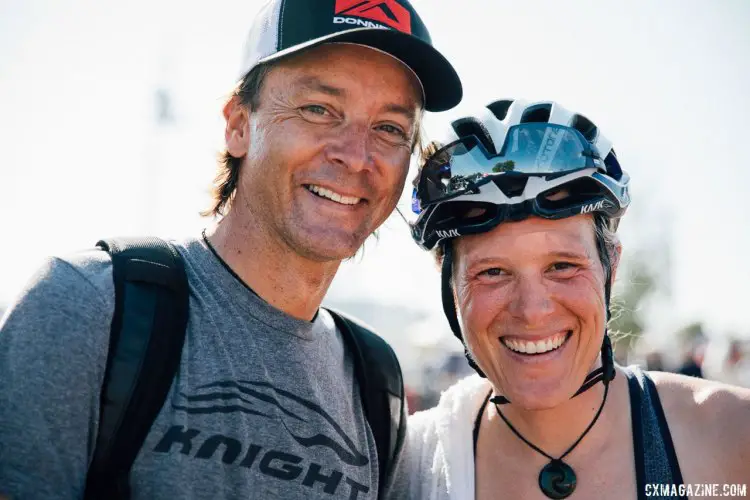
Katie Compton and Mr. Katie Compton Mark Legg have been happily riding on the figurative tandem together for a decade. You will never find them on an actual tandem, however. 2017 Trek CX Cup, Friday UCI C2. © J. Curtes / Cyclocross Magazine
CXM: We also had a question about the third member of your family. How long have you had Pixie and how did she join the family?
KFC: We’ve had her since 2010. We rescued her from a Rottweiler rescue in the Denver-Boulder area. She was hit by a car when she was a stray, so she has three legs. She’s a sweet girl. She about ten years old now and like the Denver Boulder area, um, hit by car washes, uses dry. So she’s got three legs. She’s a sweet girl. She’s about ten years old now and gets along pretty well. Very stubborn, very cuddly, loving Rottweiler. She’s great.
CXM: Were you at all that sad, I know it didn’t work schedule-wise, were you upset that you missed the Doggie Cross at Jingle Cross this year?
KFC: I was because we actually thought about it. Like, why don’t we do that with Pixie? But then we realized Pixie’s not going to jump over any hurdle, we’d have to carry her over. And when she doesn’t feel like running, she sits there and stares at you and you can’t move her at all.
I don’t think she would have done very well. I think it would have been embarrassing for the Compton family that our dog finished that far behind.
CXM: Although it would have been phenomenal because I think it was like right before your race, so the fans would have gone crazy if you were in your kit and did the Doggie Cross as your last bit of warm-up before you hit the start line.
KFC: Yeah, as I’m running trying to carry her over barriers. She’s an 80, 85-pound dog, so that’s some weight. And there’s no Paralympic category. There’s no amputee category. I figure there should be some dogs missing legs she can compete against. Let’s make it fair and all.
CXM: Then just a couple more questions. This one came from Sean of Iowa and Greg from Wisconsin. Favorite U.S. courses?
KFC: Ooh, that’s a tough one because I’ve raced so many of them and I can’t remember. Um, let’s see. I think one favorite is Devou Park in Cincinnati. I like that one. It’s pretty fun to race.
I would say probably the Kentucky and Cincinnati races be been favorites of mine over the years.
CXM: And actually, this is a perfect segue or a good question, because we’re going to have a Training Tuesday about this, but you did race at the course for Nats next year and going back to coach Compton, any advice that you have having done that race for athletes who are targeting that course? Because it’s kind of unique. It’s a hard course.
KFC: Yeah, it is hard. I think conditions are going to play a factor because if it’s muddy it’ll be different than if it’s like dry and fast. But for that course you’re going to have to do some stair sprints and also some maybe 30 second climbs.
Some sprint work. If can work on that as you kind of focus in towards race day, I think that would be a good decision. Obviously, you have to do all the other training with tempo and LT and VO2, but when you’re dialing in the course, I think the climbs are about 30 seconds apiece and then there’s quite a bit of sprinting and two stair runs. So I would work those into your training.
CXM: And then one last question. This comes from Zach S. That’s me! What role did the ice cream play in your success?
KFC: Well, I actually was pretty good about waiting until post-Worlds to indulge in the ice cream, which was hard to do. Maybe I should have eaten more of it, and I would have had more energy at the end of the race.
I was thinking about it post-race. I was like, oh, I get to eat ice cream now and I’m looking forward to it. But I feel like I may have eaten too much of it post-Worlds. There’s a lot of ice cream to eat, and I tried to share it because it was delicious.
Now I’m trying to get back to just eating healthy food, and I’m like, this isn’t nearly as fun as eating ice cream for lunch and dinner. But you have to like, just stop because I don’t want to gain that much weight in the winter because the closer you get to 40 as woman, it gets really hard to lose. So I have to be really careful with how I treat myself and when I’m eating ice cream every day for a week, it isn’t super conducive to being fit in March. Like where I’m breaking out of my chamois. So I try to indulge a little bit, but not too much.
CXM: I feel like you’ve earned it though, after a long season and Worlds, right. Like to, to let loose for a week.
KFC: Yeah. And I did, I did. It’s just at some point, you know, for me, I love sugar, I love sweets. I love cake, ice cream, chocolate, cookies. Like I love that stuff. So if I start I just want to keep eating it. For me, I have to tell myself like, okay, can indulge for so many days and you have to stop because otherwise, you know, a week turns into a month, turns into two months and before you know it, I’m like ten pounds heavier. And I’m like, where did this all come from?
CXM: And was that was delivered by the sponsor of the IJsboerke Trofee, right?
KFC: Yeah, it’s the [Ice-Boerke] Ladies Trofee. The IJ is pronounced as a long I. So it’s IJsboerke, and they make really good ice cream. They do home delivery in general, but the winner gets an ice cream delivery of whatever ice cream you want. So I got a delivery of vanilla and mocha, and there were these delicious Leonidas, like white chocolate mocha ice cream bars. They’re pretty good. And they’re small enough to be like, oh, I can have a couple. But they’re rich and delicious.
CXM: Awesome. Well, congratulations on everything you accomplished this year. I know talking to folks around Madison after Worlds, I think so many folks appreciated the great show you put on and wanteed you to win.
KFC: Thanks. Yeah, I think the amount of comments I got post-race that everybody loved it and it was their favorite race of the weekend was great. Then I got so much respect from the Belgians, so it was pretty awesome.
I think for women’s bike racing in general, it was an exciting race to watch, and it kind of put us at the forefront of ’cross racing. It’s just great for ’cross in general that it was a fun, hard raise. I’m happy how I could be part of that.
CXM: Cool. Well, enjoy your offseason and thanks again for taking the time to talk with me. I guess we’ll meet you in Waterloo in the 95,000-degree heat. I’m hoping it’s not so hot.
KFC: No, that’d be great if it wasn’t so hot and I didn’t get stung by a bee. But I’m looking forward to it. I’m like ready for ’cross season. I mean I’m glad to be done, but I’m already excited for next season, so that’s a good sign.
CXM: Cool. Well thanks so much and thanks to our readers. What are your thoughts on the questions you got?
KFC: Yeah, I thought the questions were great. I like the variety and I think they were thoughtful and I enjoyed them. I think this is fun and I’d definitely be up for another Q and A at some point.
CXM: I like that too because I don’t have to do as much work because the readers come up with the great questions.
KFC: Yeah, it’s perfect for you.























